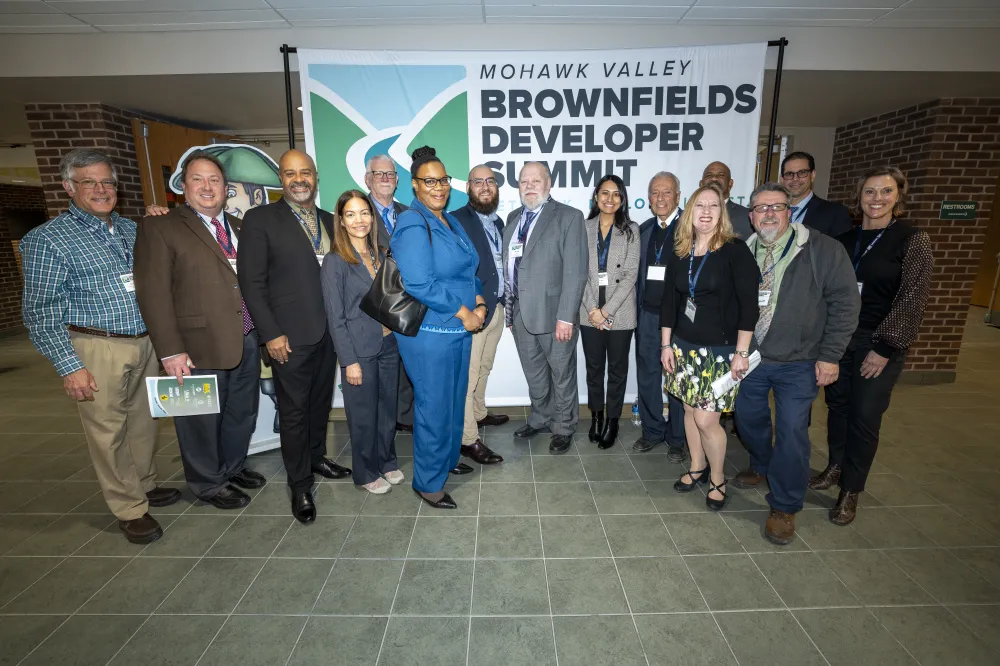The Foundation of the Mohawk Valley Brownfields Developer Summit
April 8th, 2025

Featuring Co-Founder Tom Seguljic
The Mohawk Valley is one of the oldest industrial areas in the United States. From the 1800s up until about the 1970s, it was a thriving area. Need a carpet? They were made in Amsterdam. The Utica City District had a large textile industry, producing everything from cotton and woolen cloth to stoves and furnaces. Gloversville was the center of the leather and glove industry, and the first American power knitting mill was in Cohoes.
“But then the area came off its peak,” says Principal Tom Seguljic. “Everyone shut off the lights and walked away. When I started working in New York, I recognized so many things—the existing infrastructure, the hardworking population, that it was a relatively inexpensive place. There was a lot to like, and one of the challenges was getting people to see the opportunity.”
Tom started his career at HRP in Connecticut in 1985, and when presented with the opportunity to open an office in New York in 1993, Tom took it.
“At the time, we didn’t have any clients or contacts in the area, so we were starting from scratch,” recalls Tom. “One of the things I enjoy about HRP is the challenge of growing the business. When I moved to New York, the wave of working for industry was over, and it seemed to me that the next front would be dealing with municipalities—the owners of contaminated properties.”
With a focus on building a strong network, HRP steadily grew its presence in New York, providing financial, real estate, municipal, and industry clients with due diligence, investigation, and remediation services. As HRP expanded its work across the Mohawk Valley, it became clear that many communities were struggling with neglected brownfield sites that remained unaddressed.
HRP began working closely with municipalities to navigate the challenges posed by brownfields, and tapped into the EPA’s Brownfields funding program to help drive redevelopment efforts. The foundation of the Mohawk Valley Brownfields Developer Summit emerged from this business growth.
Now in its fourth year, the Mohawk Valley Brownfields Developer Summit has expanded to include seven counties and upwards of 350 attendees. This two-day summit brings together local, state, and federal leaders to explore redevelopment opportunities in the Mohawk Valley—a chance to learn the fundamentals of brownfield projects, network with key stakeholders, and discover the incredible potential these sites hold for regional transformation.
“If you want an expert, they are at the Brownfields Developer Summit,” Tom says. “If you’re a developer, you can walk in and meet the mayor, the planning board, members of the EPA—everyone you need to talk to and everything you need to know is available in one place.”
Many developers initially believed there was no available land to develop in New York, accounting for wetlands, slopes, and a lack of infrastructure and how scarce viable land had become. The Summit has played a crucial role in shifting perspectives, educating stakeholders, and showcasing how these underutilized brownfield sites can be transformed into valuable assets. This year the Summit features a keynote by Spencer Levy of CBRE Global and US Environmental Protection Agency Region 2 Director, Michael Martucci, who were invited to share economic trends and insights on development. The Summit will also offer panels on economic development, legal issues, capital resources, site assessments, and community preparation for redevelopment.
As the Summit continues to grow, HRP is exploring new ways to enhance the experience for attendees, including live demonstrations that provide hands-on opportunities to engage with remediation technology. These demonstrations allow participants to see tools like ground-penetrating radar (GPR) and electromagnetic induction (EMI) in action, giving them a chance to observe, discuss, and fully understand the process.
With the Summit now operating under its own momentum, HRP is focused on engaging more developers and bringing them into the fold. Ultimately, the goal is to help communities advance their development projects across the Mohawk Valley, proving that brownfield sites are not just relics of the past but key drivers of the region’s future economic growth.







